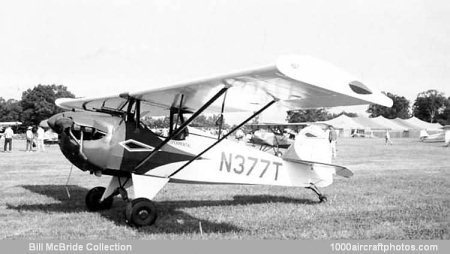Warranty:No
Country/Region of Manufacture:United States
This auction is for a complete set of 13 Blue prints for the smith termite 1 PLACE AIRCRAFT. They are in like new condition and have never been used.
STANDARD DATA: Gross wt. 658. Empty wt. 432. Wingspan 23'6". Length 15'1".
PERFORMANCE: Top mph 95. Cruise mph 83. Landing mph 38. Climb rate 450. Ceiling 6,000. Takeoff run 350. Landing roll 400. Range 150. |
The original Termite, designed by Wilbur Smith, was powered by a 36-hp, Aeronca engine, but since then other engines such as the 38-hp Continental and the 65-hp Lycoming have been used. The Termite is a single-seat sporting monoplane with a braced parasol type wing. Its wing structure is built with two wooden spars, an aluminum leading edge, and fabric covering aft of the front spar. The fuselage is an all-wood structure with plywood covering from the rear of the cockpit forward and fabric covering aft. The tail section is also fabric covered. The Termite’s landing gear is a Piper Cub type. Specifications (Smith Special "Termite")Data from Sport Aviation General characteristics - Capacity: 1
- Length: 16 ft 5 in (5.00 m)
- Wingspan: 23 ft (7.0 m)
- Airfoil: Clark Y
- Empty weight: 394 lb (179 kg)
- Gross weight: 628 lb (285 kg)
- Powerplant: 1 × Aeronca E113-C , 36 hp (27 kW)
- Propellers: 2-bladed
Performance - Maximum speed: 81 kn; 150 km/h (93 mph)
- Cruise speed: 70 kn; 129 km/h (80 mph)
- Stall speed: 28 kn; 51 km/h (32 mph)
- Service ceiling: 8,000 ft (2,400 m)
- Rate of climb: 450 ft/min (2.3 m/s)
Joseph E. Tyndal of Richmond, Virginia, constructed the pictured N377T (below) which flew for the first time on June 5, 1960. Powered by the 65 hp Lycoming O-145, it differed from the original by having the wing span enlarged by 2 ft 6 in (0.76 m) to 26 ft (7.92 m), endplates, a wheel control instead of a stick, a glass fiber cowling, and two dummy ¾-scale machine guns just in front of the cockpit.
Reportedly also designated Smittys JT-1 Termite, the aircraft's last registered owner was the EAA, its registration being cancelled on July 11, 1984.
The Smith Special also known as "Smitty's Termite" or simply the Smith Termite is a single place home-built aircraft, built primarily out of wood. The exception being the motor mount, struts and landing gear are made out of steel. It was designed to use an engine from an Aeronca aircraft, up to a 65 HP engine.
|
Plans for Sale
Mon, 01 Jun 2009
Mercedes’ R&D boffins lift lid on future in-car gadgets
By James Foxall
Motor Industry
01 June 2009 09:44
The future of in-car entertainment is on the internet, according to Mercedes-Benz. In an exclusive preview, the firm’s director of infotainment and telematics Ralf Herrtwich explained that in-car CD players and sat-navs are a thing of the past. In the future Mercedes drivers will do everything over the internet.
Wed, 23 Sep 2009
Volkswagen chose the Frankfurt motor show to unveil the revolutionary L1 Concept - a diesel-electric hybrid vehicle constructed from aluminum and carbon fiber.
Weighing 380kg, the L1 can seat two occupants in tandem. They enter through a side-hinging, electrically operated canopy which maximizes aerodynamic efficiency. It has a Cd figure of just 0.195.
Sun, 07 Sep 2014
Messrs Callum, Johnson & March chose the Top Ten Jaguars
Tomorrow – 8 September 2014 – sees the launch of the car that could make Jaguar a real force in the ‘Premium’ market – the new Jaguar XE. We’ve had lots of teases and detail of the new XE in the last few months, and now Jaguar are stating the heritage of the XE by publishing a list of the ten most important cars in their history, as compiled by a trio of Jaguar loving petrolheads – Ian Callum (Jaguar Designer), Brian Johnson (AC/DC main man) and Lord Charles March (he of Goodwood). The list kicks off with a 1930s Jaguar – the Jaguar SS100 – and goes on to include the Mark 2, C-Type, D-Type, E-Type, the original XJ6 and the Le Mans winning Tom Walkinshaw XJR-9.
2040Parts.com © 2012-2024. All Rights Reserved.
Designated trademarks and brands are the property of their respective owners.
Use of this Web site constitutes acceptance of the 2040Parts User Agreement and Privacy Policy.
0.4 s, 11215 u
|




 Zenair construction manual how to build your own - zodiac ch600
Zenair construction manual how to build your own - zodiac ch600 Zenair zodiac ch 600 plans
Zenair zodiac ch 600 plans Minimax build manual
Minimax build manual Sky pup aircraft construction plans
Sky pup aircraft construction plans Sport aircraft plans aircamper g-1 2 place 24 x 36" 11 prints cruise 95mph
Sport aircraft plans aircamper g-1 2 place 24 x 36" 11 prints cruise 95mph Sport aircraft plans aircamper corvair, cont. supplement update 15 prints
Sport aircraft plans aircamper corvair, cont. supplement update 15 prints